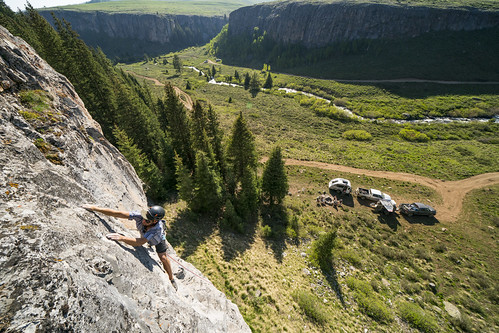Camp for Free at a National Forest!
This is the 5th annual National Forest Week, celebrating the 193-million-acre US Forest Service (USFS) and the benefits it provides to the public, including the thousands of developed and dispersed camping opportunities nationwide.

If you’re looking for a summer adventure that won’t break the bank, the USFS offers a gateway to camp, hike, fish, kayak, hunt, rock climb, swim, and more – often close to home and at no cost.

Best of all, you don’t have to be a seasoned camper or plan weeks in advance to camp at any of the 154 National Forests or 20 National Grasslands located throughout 42 states and Puerto Rico.

One of the best ways to experience National Forests is in an RV. You can bring everything you want from home to make the experience comfortable and have the resources you need if you choose to boondock (or camp off-grid) such as solar power, off-road capabilities, a bathroom, water tanks, and more. GoRVing.com has several tools to help visitors find the right RV to buy or rent for any kind of camping lifestyle.

Dispersed Camping
Whether you’re camping in a tent, car, van, or RV, there are two options at National Forests and National Grasslands. The first is dispersed, which is off-grid and away from designated areas such as campgrounds, picnic areas, trailheads, ranger stations, etc.
This is an off-the-beaten-path experience, just you communing with nature so depending on your form of camping, you’ll need to come ready for a day or more with no amenities such as external power, water hookups, fire pit, picnic table, or trash removal. Some of the more popular dispersed camping areas may have restrooms. But the great thing about RVs is that you will still have access to power, water, and other comforts while also connecting with nature.
All dispersed camping within the U.S. Forest Service is free with no reservations needed.
The best way to find what areas are available for dispersed camping, including those that allow for RVs, is to contact the office for that forest or grassland. You’ll want to stay on marked roads and look for a clearing with signs that someone has camped there already such as flattened grass or bare soil, a fire ring, or a pile of wood. Here are a few absolute musts for dispersed camping to minimize your impact on the eco-system:
• Camp at least 100 feet away from a stream or other water source.
• Park on bare soil if possible, to avoid damaging any plants or grass.
• Do not drive on meadows to set up a camp.
• Stay within 150 feet of the roadway.
• Learn how to dispose of any waste properly.

Campground Camping
For those looking for a few more amenities, try campground camping. These are developed areas that range from dry camping (no hookups) to those with water, electric, and sewer hookups. Most accommodate RVs and include a fire ring, picnic table, and a clearly marked parking area. There may also be a nearby restroom, fresh water tank filling stations, and dump stations for waste. The cost for most developed camping areas is minimal, averaging $10-$35 per night depending on the location.
• Check with the location on the availability of RV camping and any restrictions.
• Confirm any amenities ahead of time, including hookups.
• If using a generator, check with the location on any restrictions.
• If renting an RV for the adventure, videotape the walk-through before you head out.
• Reservations are typically required for designated campground camping and can be made at Recreation.gov.
A Few Things to Know Before You Go
The USFS makes it easy to find campground camping or dispersed camping options. Visitors can choose their type of camping or other recreational activities and see maps, fees, and any restrictions to ensure campers are prepared for their trip. Use the Find a Forest menu on the main Forest Service website to navigate to a specific forest. You can search for forests by state or forest name.
It's imperative you check with the location on fire restrictions including any weather conditions that will prohibit a fire and whether you can bring wood from home. Some Forests require you to buy wood from authorized outlets or burn only dead and downed wood from within the forest.
Learn and follow the Leave No Trace guidelines and leave a Pack-In Pack-Out campsite (whatever you bring with you, leaves with you)!
The number of nights you can camp ranges from 3-30, depending on the location and type of camping. Always check with your location first.
Don’t assume that water from a nearby stream is safe for drinking. Bring your own water or use a purification method.
It’s All Yours!
According to the USFS, there are 150,000 miles of trails, 10,000 developed recreation sites, 57,000 miles of streams, 122 alpine ski areas, 338,000 heritage sites, and specially designated sites that include 9,100 miles of byways, 22 recreation areas, 11 scenic areas, 439 wilderness areas, 122 wild and scenic rivers, nine monuments, and one preserve.
And remember, it belongs to all of us!
Happy Camping!
Monika Geraci is the Director of PR & Communications for the RV Industry Association and Go RVing, a board member of the RV Women’s Alliance and Communications Committee co-chair of the Outdoor Recreation Roundtable.
-

- Log in to post comments





















